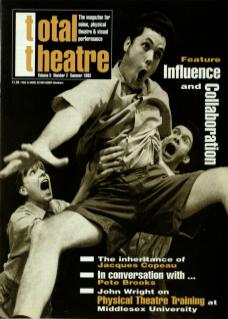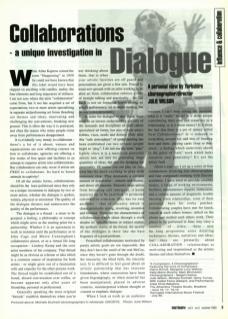When Allan Kaprow coined the term ‘Happening’ in 1959 he could not have known that this label would have been slapped on anything with candles, nudity, the four elements, and long sequences of stillness. I am not sure where the term ‘collaboration’ came from, but it too has acquired a set of expectations; two or more artists specialising in separate art / performing art forms thrashing out themes and ideas, innovating and challenging the conventions, breaking new ground. This is often the way it is portrayed, and often the reason why many people come away from performances disappointed.
It is evidently very trendy to collaborate – there's a lot of it about; venues and organisations are now offering courses on how to collaborate, agencies are offering a few weeks of free space and facilities in an attempt to organise artists into collaborations. But collaboration can only occur if artists are free to collaborate. Its hard to breed animals in captivity!
Of all the artistic forms, collaborations should be the least politicised since they rely on a unique investment in dialogue by two or more artists, whether the dialogue is spoken, written, physical or emotional. The quality of the dialogue dictates and underscores the quality of the performance.
The dialogue is a thread – a straw to be grasped, a feeling, a philosophy or concept which might serve as the starting point for a partnership. Whether it is an agreement to work in isolation until the performance, as in John Cage and Merce Cunningham's collaborative pieces, or as a virtual life long occupation – Lindsay Kemp and the core artist members of his company. That thread might be as obvious as a theme or idea which is a common source of inspiration for both artists – or might grow out of a fascination with and empathy for the other person’s work. The thread might be established out of a bored, absurd conversation over coffee, or become apparent only after years of friendship, personal or professional.
Generally speaking the most original ‘threads’ establish themselves when you're not thinking about them, that is when your artistic faculties are off guard and personalities are given a free rein. Forced to tread new ground with an artist working in an alien artform, collaboration enforces a code of straight talking and practicality – the fall back is not on formulae learnt during an artist's performance, art or music training, but on one's own personality.
In order for dialogue to take place, there must be an intense understanding not only of the demands and disciplines of each other’s specialised artforms, but also of each artist's foibles, vices, needs and desires. Only after this ‘safe atmosphere’ of understanding has been established can two or more people begin to ‘play’. I do not use the term ‘play’ lightly since it is a massively powerful artistic tool, not only for generating huge quantities of ideas, but also for dredging the personality. Of course you can play on your own but its more exciting to play with someone else. Play demands a certain amount of negotiation – consent and dissent, and above all sincerity. Sincerity stops artists from becoming self indulgent, it holds material up to be justified, it promotes constructive criticism. Play has its own aesthetic – that of sincerity which is characteristically strong, involving, inventive and focused. These are the characteristics of collaboration which shine through a work despite its specific theme or subject matter; the aesthetic clarity of the thread, the quality of the dialogue is there like the base fragrance of a good perfume.
Prescribed collaborations motivated by purely artistic goals are not impossible. But they don't have the smell of the real McCoy, since they haven't gone through the doubt, the insecurity, the blind faith, the sincerity test. It is difficult to feel good about an artistic partnership that has insecure foundations, where concessions have been given begrudgingly, or when material has been manipulated, placed in adverse contexts, misinterpreted without thought or consent or emphatic dialogue.
When I look at work as an audience member, I can't help asking the question, what is it really ‘about’? Is it about people contributing their time and creativity to a relationship, or is it about money? Is it about the fact that there is a pot of money called New Collaborations? Is it reduced to scratching around for odd bits of funding here and there, playing cards close to their chest – a feeling which underlines shows in the guise of ‘safe’ work which lacks sincerity and generosity? It's not the artists' fault.
About a year ago I set up a series of four commissions involving four choreographers and four composers working with Electro-acoustics. I have tried to provide sensible money, a range of working environments, facilities, administrative support, enthusiasm, and a certain amount of diagnostic trouble shooting when relationships, some of them personal, have hit rocky patches. Collaborating couples have met for lunch, stayed at each other’s homes, talked on the phone, and studied each others work. Their pieces, to be performed in June, may carry a number of titles, there may be long programme notes detailing techniques, themes, narratives and ideas, but they are primarily about collaboration – relationships as motivating and inspirational as the artistic themes and ideas themselves.
4 Composers, 4 Choreographers will feature the work of composers Diana Burrell, Margaret Lucy-Wilkins. Kelly-Marie Murphy, and Mark Bromwich, and choreographers Abigail Owens, Julie Wilson, Michele Durtnell, and Gerry Turvey. With Cellist Fiona Gibbard, and Performance Artist Chris Batstone. The Alhambra Theatre Studio, Bradford – June 16, 17, 18, 19. Harrogate International Music Festival – July 30.

